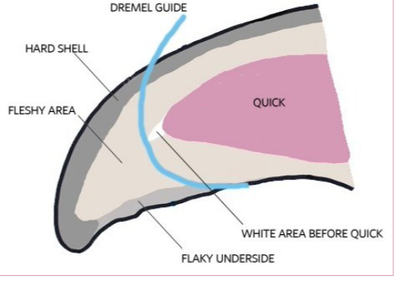Caring for Your Doberman's Nails
Affects of Nail Neglect
Taking care of your dog’s nails is an often overlooked aspect of dog care. In my day job at a boarding facility, I often see dogs belonging to owners who just pay for a bath at each visit, while their dogs nails go untouched. Just last week, I saw the devastating affect overgrown nails can have with a small chihuahua whom had nails so long they were growing into her paw pads. The worst part of this situation was not the nail piercing the paw pad (or in other cases I have seen, the common infection that occurs as a result), it’s how it affects the dog’s walking ability. It was obvious that the nails had been overgrown for so long, that the poor dog’s paw structure (bones, tendons, ligaments, and muscles) had been permanently altered from walking with her paw curled. Unfortunately the damage at this point was too severe and likely permanent without a corrective surgery. She walked with a severe limp before and a severe limp after those nails were shortened to an acceptable length. A simple monthly nail trim would have spared her from this permanent handicap.
I share the story above to highlight the very serious consequences that nail neglect can have on a dog’s life. I’ve never seen a dog tear tendons or have their foot bone structure permanently change because they’re overdue for a bath. But, baths often take priority for most dog owners over any other grooming needs, when they’re usually a bath is last on the totem pole of necessity. Owners love when their dogs smell good, but I always care more about if the dog feels good!
The most common affect from overgrown nails is the sprawling of a dog’s paw to adjust. Instead of sitting high on their feet, the foot sprawls down, the bones extend and the foot lays flat on the floor. The toes often slant to one side to accommodate that long nail. Once the foot is this deformed, it is often the way it will stay. Other affects include: nails cracking/splitting and nail injury from the nail getting caught in something.
Dremeling vs Clipping
Dremeling dog nails takes more work and practice, but it is so much better than a traditional nail clipper for so many reasons.
- Dremeling, when done correctly, is painless. All that is felt by your European Doberman is vibration. Clippers are a crushing/cutting motion that cause some sort of pain at minimum some of the time. Because of this unpredictable discomfort, dogs will associate that pain with the nail clippers and be unwilling, even aggressive or fearful, to have their feet touched, let alone their nails taken care of.
- You’re likely to cut the quick with clippers, which is extremely painful and scarring for your European Doberman. With a dremel, even if you do hit the quick, if you’re paying attention and careful, it will be pain free, and the nerves in the quick will be 99.9% undamaged.
- Dremeling allows shaping and smoothing of your European Dobermans nail. You can shape with clippers, but it takes a lot of skill and experience, but you still can’t smooth the nail out.
- Dremeling allows you to expose the quick on all 4 sides, and this will let the quick recede, meaning over time it will get shorter. With clippers, you’re limited to cutting the same spot over and over, unless you are willing to hurt your Doberman by knowingly cutting the quick each time, but that would be cruel.
What You Need
You really only need one tool which is a dremel and the accompanying sandpaper, and a flat place to sit next to a power outlet. You don’t want to get a crappy Oster nail dremel, they break after not too long, and don’t have nearly enough power, especially for thick European Doberman nails. This is the dremel we have and it will last you for years. There will be a bit of nail dust, so if you’re worried about that, doing the dremel outside is not a bad idea and/or with a disposable facial mask.
Click Here for a Dremel Recommendation
Click Here for a Dremel Recommendation
Nail Anatomy
The nail consists the quick, an inner softer nail, and the outer hard shell. The hard shell typically goes all the way around, including the underside, but on some nails that are shorter the underside will be a very short amount of soft nail, and then the quick.
|
Doberman nails take a little more skill to shorten properly due to them being black. Nails that are white have an easily visible quick (pink) without having to do any trimming. With practice, you’ll get to where you can make a good guess on where the quick is on dogs with black nails before having to do any dremeling.
The quick is the main focal point when dremeling. The quick is filled with nerve endings and blood vessels, which means it is the part of the nail that will feel pain. It is to be avoided at all costs, but at the same time you want it slightly exposed so it will recede. |
How to Dremel
We especially recommend watching the video accompanying this article (see the top of this page). It’ll be much clearer to see in real time the explanation of each step.
Each motion should be a “rounding” motion, not a “hard pressing in one direction” motion. The dremel head can heat up pretty quickly causing pain, and you’re more likely to hit the quick if you’re just pushing straight down and in one spot. The rounding motion also ensures that if the quick is longer than you thought, you don’t run of of grinding room and are left with a sharp nail. Consistent rounding motion makes sure that your tip is always rounded and smooth (for the most part).
I prefer to take off the hard shell all the way around (underside included) and then evaluate and try to see how long the quick is. Then, starting at the tip, in a rounding motion work my way down. As you’re working your way down, be sure to round the nail from front to back and side to side, keeping it evenly rounded. Once the quick is exposed your maneuverability and options are greatly diminished. Pause and look after each few go arounds to see if you can see the beginnings of the quick. Once you do, start being more deliberate in your shaping. The goal is to have a rounded nail with no jagged edges, smooth sides, and the quick exposed as much as possible.
Nails on the same foot almost always have similarly length’d quicks. So once you have done one, the rest should be faster to do since you have a better idea where the quick is.
Other Things to Know
Your Doberman will naturally keep their nails short by running. When their nails hit sand/rocks/pavement, they will slightly file themselves. Dobermans that are more active, especially in environments that are rougher (blacktop, heavily rocked areas, etc) will not need their nails shortened as often.
You’ll notice that either the front or back nails on your Doberman are longer than the other. This will show you if they mainly push themselves forward from their back feet or pull themselves forward with their front feet. The paws that do the most work are dug into the ground harder, keeping the nails shorter.
Doing this method of nail care (dremeling) at a young age for your Doberman will mean that when they’re adults, they’ll lay almost completely still while you do it. If you get a European Doberman Puppy from us here at Von Hohenhalla Dobermans, this is the method we use to dremel their nails from 4 weeks onwards. Our puppies will have already been started with positive experiences!

